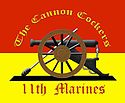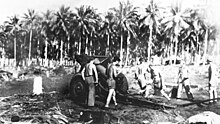
The 1st Marine Division is a Marine division of the United States Marine Corps headquartered at Marine Corps Base Camp Pendleton, California. It is the ground combat element of the I Marine Expeditionary Force.

The 1st Marine Regiment is an infantry regiment of the United States Marine Corps based at Marine Corps Base Camp Pendleton, California. The regiment is under the command of the 1st Marine Division and the I Marine Expeditionary Force. The 1st Marine Regiment is also sometimes referred to as "Regimental Combat Team 1" or "Inchon".

The 5th Marine Regiment is an infantry regiment of the United States Marine Corps based at Marine Corps Base Camp Pendleton, California. It is the most highly decorated regiment in the Marine Corps and falls under the command of the 1st Marine Division and the I Marine Expeditionary Force.

The 7th Marine Regiment is an infantry regiment of the United States Marine Corps based at Marine Corps Air Ground Combat Center Twentynine Palms, California. Nicknamed the "Magnificent Seventh", the regiment falls under the command of the 1st Marine Division and the I Marine Expeditionary Force.

3rd Battalion, 11th Marines (3/11) is an artillery battalion comprising three firing batteries, a Liaison Unit, and a headquarters battery. The battalion is based at the Marine Corps Air Ground Combat Center Twentynine Palms, California and its primary weapon system is the M777 lightweight howitzer with a maximum effective range of 25 miles. They fall under the 11th Marine Regiment and the 1st Marine Division.

3rd Battalion, 1st Marines (3/1) is an infantry battalion in the United States Marine Corps based out of Camp Horno on Marine Corps Base Camp Pendleton, California. Nicknamed the "Thundering Third", the battalion consists of approximately 1,200 Marines and Sailors and falls under the command of the 1st Marine Regiment and the 1st Marine Division.

The 1st Marine Logistics Group is a logistics unit of the United States Marine Corps and is headquartered at Marine Corps Base Camp Pendleton, California, with several subordinate elements also located at Marine Corps Air Station Yuma and Marine Corps Air Ground Combat Center Twentynine Palms.
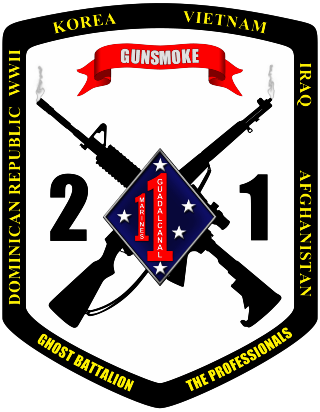
2nd Battalion, 1st Marines (2/1) is an infantry battalion in the United States Marine Corps based in Camp HORNO on Marine Corps Base Camp Pendleton, California. Nicknamed "The Professionals," the battalion consists of approximately 1,200 Marines and Sailors. Normally they fall under the command of the 1st Marine Regiment and the 1st Marine Division.

The 10th Marine Regiment is an artillery regiment of the United States Marine Corps based at Marine Corps Base Camp Lejeune, North Carolina. They fall under the command of the 2nd Marine Division and the II Marine Expeditionary Force.

1st Battalion, 5th Marines (1/5) is an infantry battalion in the United States Marine Corps based out of Marine Corps Base Camp Pendleton, California consisting of approximately 800 Marines and sailors. Nicknamed Geronimo, it falls under the command of the 5th Marine Regiment and the 1st Marine Division. The battalion was formed in 1914 and has served in every major conflict that the United States has been involved in since then.

The 1st Battalion, 7th Marines (1/7) is an infantry battalion of the 7th Marine Regiment of the United States Marine Corps. It is currently based at the Marine Corps Air Ground Combat Center Twentynine Palms. Consisting of approximately 1,000 Marines, it is part of the 1st Marine Division.

1st Battalion, 11th Marines (1/11) is an artillery battalion comprising four firing batteries and a Headquarters battery. The battalion is stationed at the Marine Corps Base Camp Pendleton in California. Its primary weapon system is the M777 lightweight howitzer. The battalion is under the command of the 11th Marine Regiment, part of the 1st Marine Division.

2nd Battalion, 11th Marines (2/11) is an artillery battalion comprising four firing batteries and a Headquarters Battery. The battalion is stationed at Marine Corps Base Camp Pendleton, California. Its primary weapon system is the M777 lightweight howitzer. The battalion was the first in the Marine Corps to fully transition from the M198 Howitzer. They fall under the command of the 11th Marine Regiment and the 1st Marine Division.

5th Battalion, 11th Marines (5/11) is a High Mobility Artillery Rocket System (HIMARS) battalion consisting of four Firing Batteries and a Headquarters Battery. The battalion is stationed at Marine Corps Base Camp Pendleton, California. It is the first active duty HIMARS Unit in the Marine Corps. They fall under the command of the 11th Marine Regiment and the 1st Marine Division. This is the only battalion in the 11th Marine Regiment not using the M777A2 lightweight howitzer.
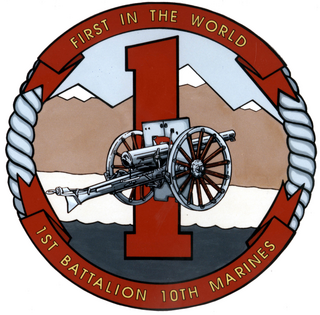
1st Battalion, 10th Marines (1/10) is an artillery battalion composed of five firing batteries and a headquarters battery. The battalion is stationed at Camp Lejeune, North Carolina and falls under the command of 10th Marine Regiment, part of 2d Marine Division. Its primary weapon system is the M777A2 155mm lightweight howitzer.

5th Battalion 10th Marines (5/10) was a US artillery battalion comprising three firing batteries and a headquarters battery. The battalion was stationed at Marine Corps Base Camp Lejeune, North Carolina, USA and its primary weapon system was the M777A2 howitzer, with a maximum effective range of 30 km. They fell under the command of the 10th Marine Regiment and the 2nd Marine Division. The battalion was known by its nickname of, "The Five and Dime."
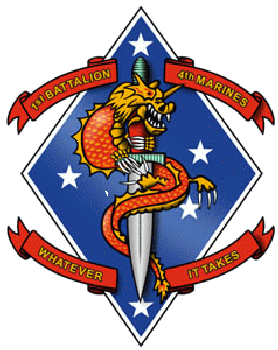
1st Battalion, 4th Marines (1/4) is an infantry battalion in the United States Marine Corps based out of Marine Corps Base Camp Pendleton, California consisting of approximately 800 Marines and sailors. They fall under the command of the 1st Marine Regiment and the 1st Marine Division.
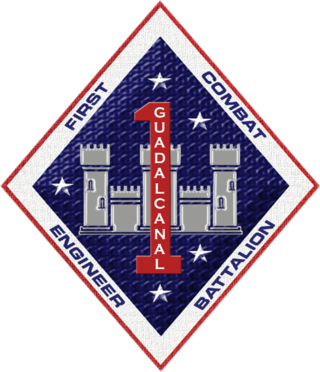
1st Combat Engineer Battalion is a combat engineer battalion of the United States Marine Corps. The unit, nicknamed "The Super Breed", is based at Marine Corps Base Camp Pendleton, California and falls under the command of the 1st Marine Division and the I Marine Expeditionary Force.

1st Battalion, 12th Marines (1/12) was an artillery battalion comprising three firing batteries and a Headquarters Battery. The battalion was stationed at Marine Corps Base Hawaii and fell under the 12th Marine Regiment and the 3rd Marine Division. It was deactivated on 26 May 2023.

1st Medical Battalion is a unit of the United States Marine Corps operated by the United States Navy that provides expeditionary Health Service Support to Marine Corps forces forward deployed to operations or humanitarian missions. The unit is based out of Marine Corps Base Camp Pendleton and falls under the command of 1st Marine Logistics Group.
